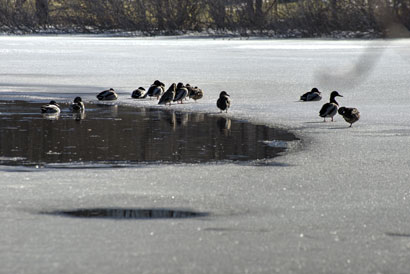“Winter weather whiplash” is a catchy term that describes unusual and unexpected changes in weather, like a false spring in the dead of winter. But these meteorological mood swings can have more severe effects than the false hope of an end to the winter chill.
Whiplash events can affect ecosystems that are seasonally covered by snow—and the people living and working in these areas. An interdisciplinary team of researchers is now trying to define these whiplash events to understand the ways they affect natural and human ecosystems. They hope that their work will inform preparations for future events.
Alix Contosta, a soil scientist at the University of New Hampshire, described winter weather whiplash like this: “You can sort of envision what whiplash is—in terms of being in an accident and the damage to your health—so the term is kind of a metaphor for the impacts for a community or an ecosystem.” Contosta presented this research this month in a poster session at AGU’s Fall Meeting 2018 in Washington, D. C.
Winter Weather Whiplash by the Numbers
More formally, the researchers defined a winter weather whiplash event as a day when two types of weather coincide, such as a heavy snowstorm when the leaves are still on the trees or a heat wave that’s uncharacteristic for the time of year.

Then they searched for whiplash events at the Hubbard Brook Ecosystem Study (HBSE) site in New Hampshire’s White Mountain National Forest. For their search, they scoured records of daily rainfall and snowfall, recorded temperatures, and a measure of how green the trees were, using data collected at HBSE between 1956 and 2017.
But the team needed another metric—a quantifiable “tell”—that could be used to detect events in the past and possibly to prepare for future events. Amy Burgin, who also studies weather whiplash related to rainfall and droughts, agrees that it’s essential to use something that can be measured to define whiplash events. “If we can quantify something, we can start to link it back to other models that allow us to predict into the future,” she said. Burgin is a biogeochemist at Kansas Biological Survey who was not involved in the research.
So to quantify the effects of winter weather whiplash events, the researchers analyzed water flowdata (the amount of water flowing past a given point) and how often streams flooded. They reasoned that water flow would be an accurate indicator of how whiplash events affect ecosystems and people. Water flow is an indicator of such environmental factors as soil thaw and rainfall, but it also has a direct effect on people when, for example, floods damage roads and buildings.
When the researchers looked at the dates when significantly high flow rates were recorded, they noticed that many of those days coincided with whiplash events such as false springs or a return to above-freezing temperatures after an off-season snowstorm.
“This really suggests to us that there’s something there in our conceptual model,” said Nora Casson, a geographer at the University of Winnipeg who also presented the poster.
Snowtober Wreaks Havoc
The researchers also noted that the winter weather whiplash events they identified coincided with anomalous weather that they had experienced firsthand or heard about on the news.
One example was the snowstorm that passed over the northeastern United States on the heels of Hurricane Irene in October 2011. This unusually early, heavy snowfall—dubbed “Snowtober”—ruined harvests, downed power lines, and shut down the electrical grid in some areas.
The team hopes that their research will be useful to scientists trying to understand ecosystems and climate change, as well as to policy makers trying to put mitigation and adaptation measures in place to prepare for these events in the future.
“These events disrupt ecosystems in really damaging ways, so they could end up impacting human communities in big ways that we don’t expect,” said Casson.

Climate Change Conversations
Making small talk about drastic changes in the weather can also be a good way to start conversations about sensitive issues like climate change.
“People remember the crazy weather that we’re having, so it’s a useful entry point for engaging with people about climate change and what some of the impacts could be,” said Contosta.
Sarah Nelson, a biogeochemist at the University of Maine who also presented the poster, agrees that talking about winter weather whiplash events is really important for these conversations.
“Sometimes people have a built-in conception that climate change is all about warming, but variability is a huge part of climate change, and these events highlight that,” she said. “Just because it snows in October doesn’t mean that warming isn’t happening; it’s just very up and down.”
—Sofie Bates (sofiebates@gmail.com; @sciencesofie), Science Communication Program Graduate Student, University of California, Santa Cruz
